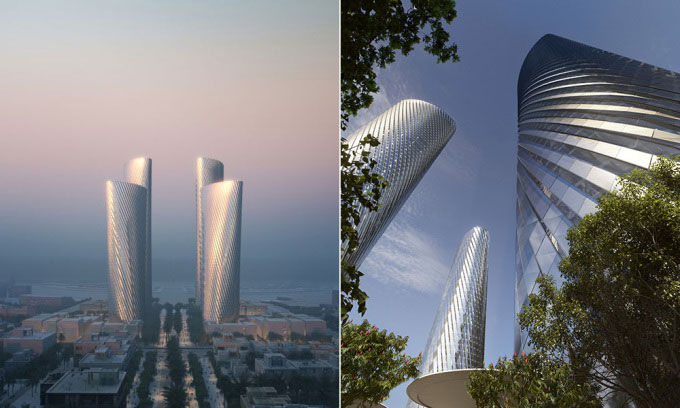Qatar's tallest tower cluster resists heat thanks to its aluminum sheet covering
The 301m high Lusail tower cluster uses aluminum sunshades that look similar to fish gills, helping to reduce solar radiation by 70% compared to using glass.
Nearly completed with a height of 301m, the Lusail tower complex by famous architect Norman Foster will win the title of tallest building in Qatar, surpassing the current record holder, The Torch Doha hotel, 300m high , CNN on June 29 /2 reported.

Design of Lusail tower cluster in Qatar. (Photo: Tomorrow AB/Foster + Partners)
The tower complex began construction in January 2020, expected to be completed in stages over the next 12 months. This project is located in Lusail city, part of a project with a total area of 1.1 million m2 by British architectural firm Foster + Partners . The tower cluster consists of 4 separate blocks, two blocks are 70 floors high and two blocks are 50 floors high. Each tower is expected to function as a hub for Qatar's financial institutions.
To address the unique challenge posed by Qatar's hot climate, Foster's team eliminated some materials commonly used for high-rise buildings in cooler countries. According to Foster, this is part of a long-term mission to innovate high-rise buildings. "You've thought many times about the tower being a glass structure, but with the climate here and the issue of sustainability, you really want to protect the building from heat gain from the Sun," , he said.
The design of the Lusail tower cluster integrates an advanced sunshade and ventilation system, while the exterior of the tower cluster is surrounded by "marine standard" aluminum, protecting the glass from harsh sunlight, while still maintaining The view faces outward and receives natural light. At the heart of the project are special sunshades that look similar to fish gills, helping to reduce solar radiation by 70% compared to traditional towers that use all-glass.
Aluminum panels help shield the tower cluster from harsh sunlight. (Photo: Tomorrow AB/Foster + Partners)
"What we do is create awareness based on real needs. It's not an imposition of fashion but comes from climate reality ," Foster said.
The shading system contributed to a 35% reduction in cooling needs and overall energy consumption, according to Luke Fox, project leader and senior executive partner at Foster + Partners.
The towers are strategically placed to create maximum shade. When rising, their shape also changes when twisted 90 degrees. "We made sure that the towers were intentionally arranged to twist slightly, providing views between the towers as they rise. This is quite unique ," Fox shared.
- New aluminum alloy fabrication withstands 400 degrees Celsius
- The tallest tower in the world
- Norway built the world's tallest wooden tower
- Saudi Arabia built the tallest skyscraper in the world
- The tallest tower in the world is forming
- Video: Burj Khalifa tower is the world's highest usurpation tower
- Japan plans to build a tower of 1.6 kilometers high
- 10 tallest buildings in the world
- Israel strives to build the world's tallest solar tower
- The tallest tower in the world will be over 3,000 meters high
- Japan opens 'world's tallest elevator tower'
- Invention of a new type of brick that can store heat
 Norway built the world's tallest wooden tower
Norway built the world's tallest wooden tower Kremlin
Kremlin Ashurbanipal: The oldest royal library in the world
Ashurbanipal: The oldest royal library in the world Decoding the thousand-year construction of Qin Shihuang shocked the world
Decoding the thousand-year construction of Qin Shihuang shocked the world